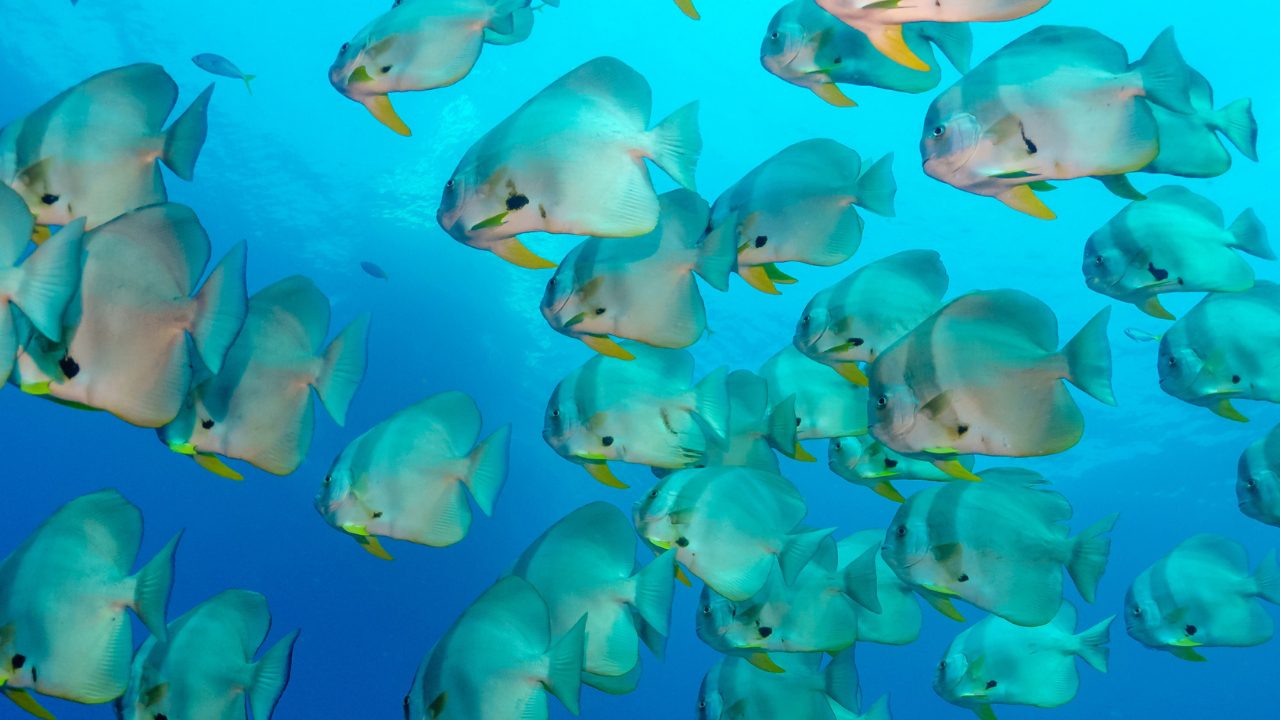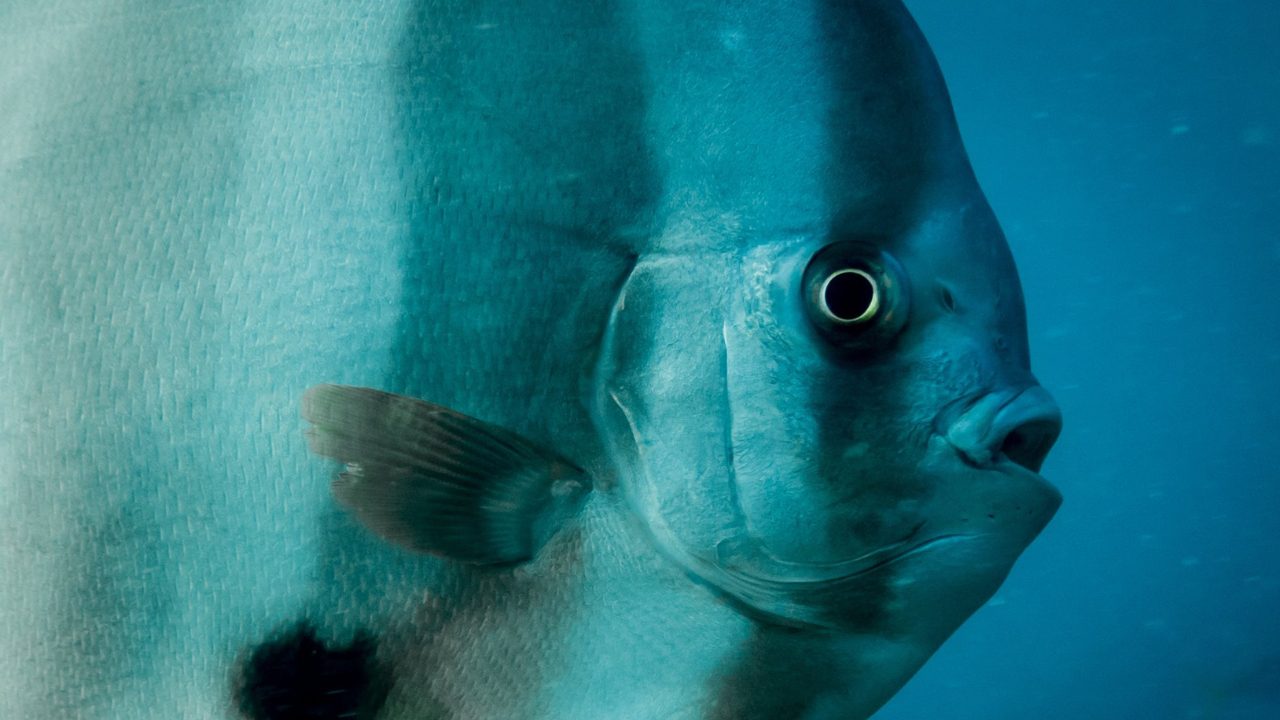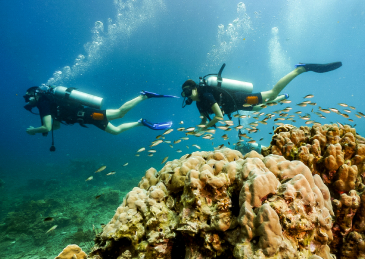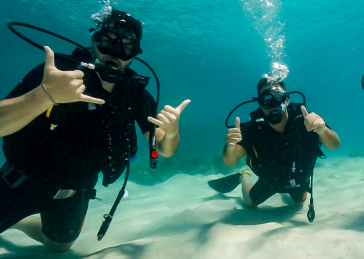Modified 9th June 2025
Batfish Koh Tao: Complete Guide to Longfin Batfish Encounters
Among the diverse marine life inhabiting the waters surrounding Koh Tao, the Longfin Batfish stands out as one of the most distinctive and charismatic species. These social creatures with their unusual diamond-shaped bodies and elongated fins capture the attention of divers exploring Thailand’s underwater paradise, often approaching visitors with apparent curiosity rather than fleeing like many other reef fish.
Understanding where and when to find batfish Koh Tao, along with their behavior patterns and identification features, enhances every underwater encounter and contributes to meaningful marine life observations that make Koh Tao diving truly special.

Identifying Batfish Koh Tao: Physical Characteristics
Longfin Batfish Identification Guide
En Platax teira is immediately recognizable by its highly compressed, disc-like body forming a distinctive diamond or triangle shape. Adults typically grow 30-40 cm in length, though specimens reaching 70 cm have been recorded around Koh Tao.
- Bright yellow coloration with dark vertical bars
- More rounded bodies with proportionally longer fins
- Leaf-like swimming pattern mimicking floating debris
- Boomerang-like appearance when viewed from side
- Often mistaken for floating plant matter
- Silvery-gray bodies with defined diamond shapes
- Prominent dark stripe through eye area
- Dramatically elongated dorsal and anal fins
- Yellowish or black edges on extended fins
- Small mouths with brush-like teeth for grazing
Best Dive Sites for Batfish Koh Tao
Batfish Koh Tao sightings occur at multiple dive sites around the island, with certain locations offering more reliable encounters depending on experience level and diving conditions. Understanding the best time to dive Koh Tao enhances your chances of memorable batfish encounters.
| Dive Site | Depth Range | Experience Level | Sighting Chance | Best Time |
|---|---|---|---|---|
| Chumphon Pinnacle | 18-30 meters | Avanzado | High | Early morning |
| White Rock | 12-25 meters | Intermediate | High | All day |
| Pináculo del Suroeste | 15-28 meters | Avanzado | High | Morning/afternoon |
| Isla del Tiburón | 5-18 meters | Beginner | Medium | All day |
| Gemelos | 8-20 meters | Beginner | Medium | Morning |

Batfish Behavior and Social Structure
Understanding Batfish Behavior Patterns
Longfin Batfish are highly social creatures that exhibit fascinating behaviors making them particularly engaging for underwater observation around Koh Tao.
Typically found in groups of 3-5 individuals, though larger aggregations of dozens can occur at sites like Chumphon Pinnacle during optimal conditions.
Naturally curious disposition leads batfish to approach divers rather than flee, often hovering nearby in their distinctive vertical posture to inspect visitors.
Semi-pelagic lifestyle means they travel throughout the water column and across different habitats rather than maintaining defined territories.
Distinctive vertical feeding posture while picking at algae and small invertebrates, allowing efficient maneuvering between coral structures.
Conservation Status and Threats
Batfish Koh Tao Conservation
While Longfin Batfish are not currently endangered, they face various threats common to reef fish in the Gulf of Thailand requiring ongoing conservation attention.
Coral reef degradation due to climate change and sedimentation reduces suitable habitat for all life stages.
Occasionally caught as bycatch or for aquarium trade, particularly colorful juveniles.
Generally resilient to diver presence, though excessive traffic and poor practices can disrupt behavior.
Artificial reef projects, cleanup dives, and diver education programs help protect batfish habitat.
Test Your Batfish Knowledge
Batfish Koh Tao Identification Quiz
Test your understanding of Longfin Batfish characteristics and behavior patterns around Koh Tao:
Ready to experience the magic of batfish encounters in Koh Tao’s pristine waters? La Bombona Diving offers expert-guided trips to the best batfish sites around the island, ensuring memorable underwater encounters with these charismatic diamond-shaped fish.
- Expert local guides who know batfish behavior patterns
- Access to premium sites like Chumphon Pinnacle and White Rock
- Small groups for better wildlife observation
- Marine life identification briefings
- Flexible scheduling for optimal sighting conditions
- Professional underwater photography tips
- Conservation-focused diving practices
- All experience levels welcome
Whether you’re planning your first visit or returning to explore more marine life around Koh Tao, our experienced team ensures safe and educational encounters with the island’s fascinating batfish populations. Getting to this diving paradise is easier than ever with comprehensive transport options from anywhere in Thailand.
Book Your Batfish Adventure – Fun Dives ฿2,0002 dives | 4 hours | All equipment included | Perfect for batfish spotting
Preguntas frecuentes
Bucea con LBD: tu puerta a la exploración submarina
Whether you’re a curious beginner or a seasoned pro, our school is your portal to the wonders of scuba diving. Join us into the world beneath the waves.
¿LISTO PARA EMPEZAR?
Consulta nuestros cursos de buceo en Koh Tao



